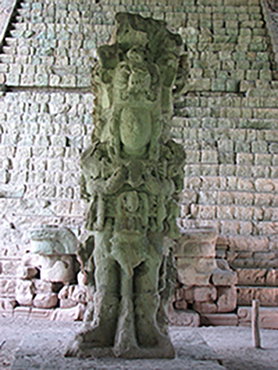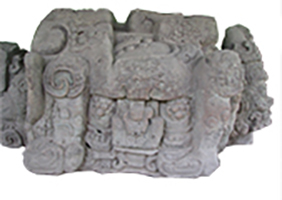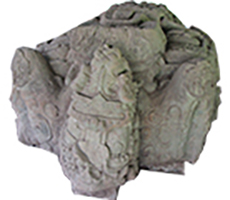Stela M
Location: Base of the Hieroglyphic Stairway
Dates: 9.16.5.0.0 8 Ajaw 8 Zodz / 756
Rulers: 15
Measurements: 11 feet x 3.6 feet x 2.66 feet, cribbing 6.89 feet x 6.3 feet x 1.5 feet



Photos (Edited) Courtesy of Dr. Clark Erickson
Stela M is the first stela in Copan since Waxaklajuun Ubaah K’awiil’s death at the hands of Quirigua nearly twenty years prior (Fash 1991, 139). The thirteenth ruler’s successor, K’ahk’ Joplaj Chan K’kawiil was known for not having built any stelae, although he may have commissioned a structural renovation for his more local government. Considering the level of high relief and the fact that this stela and its associated altar marked the dedication of the second phase Hieroglyphic Stairway, K’ahk’ Yipyaj Chan K’awiil certainly departed from this strategy in favor of ostentation and large-scale efforts to rekindle national pride (Baudez 1994, 74).
Both Stela M and its accompanying altar were impressive pieces of sculpture even by Copan’s standards. Though both monuments are fairly eroded, and the stela was found in the nineteenth century in pieces, an exceptional amount of detail can be seen on both (Baudez 1994, 74-75). Stela M was a Type VI stela with its wraparound design and no side specifically devoted to glyphs (Fash 2004, 259). Of note, the bulk of the previous stelae that used this style were created by Waxaklajuun Ubaah K’awiil (Martin and Grube 2008, 204). His choice to use this style of stela probably aimed to pick up where the thirteenth king left off and, along with the ambitious new installment of the Hieroglyphic Stairway, remind the people of Copan’s glory.
Further supporting this idea, in the cruciform cache under the stela’s platform was housed various ceramics, jadeite, stalactites, and a spondylus shell treated with mercury (Baudez 1994, 74). The spondylus shell was a high end luxury item in Copan, which only a king could afford to give in offering (Stone and Zender 2011, 167). Though Copan had lost its foothold in the Motagua Valley and had an injured reputation, the king still put forward lavish offerings to insist that they were not defeated.
The figure - K’ahk’ Yipyaj Chan Yopaat stands facing forward, carrying the serpent bar, from which K’awiil heads emerge bearing the stone glyph and the torch or “axe and smoke” as Baudez calls it in their forehead, evoking the “k’awiil” - the symbol of royal authority (Baudez 1994, 74). K’awiil in the forehead specifically may symbolize a king’s apotheosis as the God K, patron of kings (Fash 1991, 177). Yax K’uk’ Mo’ had seized this bar to begin his dynasty roughly three hundred years prior.
The figure bears a crocodile helmet on his head, lancets on his wristlet, and the solar jaguar snakes and eyes on his loincloth (Baudez 1994, 74) Interestingly, the crocodile head has shells instead of ears, which feature blackened U’s. This may have been a reference to the thirteenth ruler’s name, which has been translated as “Smoke Shell”. For another instance of a literal reference to K’ahk’ Yipyaj Chan Yopaat, see the temple for the Hieroglyphic Stairway (Fash 1991, 149). On his belt are panels of the crossed bands glyph associated with the Founder. The figure is surrounded by a number of grotesques. The stela also features serpents against a feathered background with rosettes and braid and tassel embellishments (Baudez 1994, 74-76).
The Altar




From the top left to right, South side, East side, West side, North side
Photos (Edited) Courtesy of Dr. Clark Erickson
The associated altar also fits in with the elaborate carving strategy as a Witz zoomorph, or the cave entrance to the underworld (Baudez 1994, 76; Fasquelle 2004, 109). The altar is comprised of three pieces, with the base forming the crocodilian body and two heads that fit into the north and south alcoves. The body has three Witz masks on the top, east, and west and three sided deer feet made of shells (Martin 2015, 217; Baudez 1994, 77).
The life head was identified in the south with two instances of the Star of Venus, and had a bakab head, or the head of the “Old Man” God N, emerging from its mouth, holding up the sky (Baudez 1994, 77 - 80; Martin 2015, 217, 189). This head also has a serpent jaw, three circles on the earrings, and motifs around the eyes and cord on its forehead. The life head also wears a hatched bonnet, which may be a variant on the mat motif, signaling royalty. The death head in the north also wears a bonnet as well as a braid, the underworld tripartite emblem, and, fittingly, skeletal jaws. The head also has a rectangular k’in cartouche, which could be interpreted as a symbol of warfare (Stone and Zender 2011, 153). The star markings and witz masks on the crocodile insinuate a creature who either represents both the heavens and earth in one or a primordial being who existed before the two were split (Martin 2015, 217-218). This union may be a further reference to the spirit world and cosmic order.
K’ahk’ Yipyaj Chan Yopaat’s stela combined with the altar suggests him emerging from the Underworld and rising in accession (Baudez 1994, 80). Furthermore, the crocodilian helmet could be used to associate the fifteenth ruler with the world axis, asserting his necessity to the cosmic order (Stone and Zender 2011, 183). The first stela since the thirteenth king’s demise revives his flair for ostentation particularly when combined with the Hieroglyphic Stairway, K’ahk’ Yipyaj Chan Yopaat emphasizes both his strength as a ruler and the strength of his city.
Motifs:
- Bicephalic serpent
- Braid and Tassel
- Crocodile
- Crossed bands
- God K
- Lancet
- Serpent bar
- Solar Jaguar
- Spondylus Shell
- Torch in forehead
- Venus
- Witz
See Also:
Sources:
- Baudez, Claude-François. 1994. Maya Sculpture of Copán: The Iconography. Norman: University of Oklahoma Press.
- Fash, Barbara W. 2011. Copan Sculpture Museum, The. Cambridge: Peabody Museum Press.
- Fash, Barbara W. 2004. “Early Classic Sculptural Development at Copan.” In Understanding Early Copan, edited by Ellen E. Bell, Marcello A. Canuto, & Robert J. Sharer, 249-264. Philadelphia: University of Pennsylvania Museum of Archaeology and Anthropology
- Fash, William L, 1991. Scribes, Warriors, and Kings: The City of Copán and the Ancient Maya. New York: Thames and Hudson.
- Fasquelle, Ricardo Agurcia. 2004. "Rosalila, Temple of the Sun-King". In Understanding Early Copan, edited by Ellen E. Bell, Marcello A. Canuto, & Robert J. Sharer, 101-112. Philadelphia: University of Pennsylvania Museum of Archaeology and Anthropology
- Martin, Simon. 2015. "The Old Man of the Maya Universe: A Unitary Dimension to Ancient Maya Religion". In Maya Archaeology 3, 186-227. San Francisco: Precolumbia Mesoweb Press
- Martin, Simon and Nikolai Grube. 2008. Chronicle of the Maya Kings and Queens: Dynasties of the Ancient Maya. London: Thames and Hudson
- Stone, Andrea and Marc Zender. 2011. Reading Maya Art: A Hieroglyphic Guide to Ancient Maya Painting and Sculpture. London: Thames and Hudson.
- Taylor, Dicey. 1978. “The Cauac Monster,” In Tercera Mesa Redonda de Palenque, edited by Merle Greene Robertson and Donnan C. Jeffers, 79-90. Monterrey: Pre-Columbian Art Research Center, 1978).